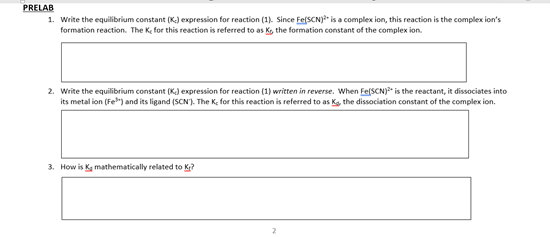1. Write the equilibrium constant (K) expression for reaction (1). Since Fe(SCN)" is a complex ion, this reaction is the complex ion's formation reaction. The Ke for this reaction is referred to as K, the formation constant of the complex ion. 2. Write the equilibrium constant (K) expression for reaction (1) written in reverse. When FelSCN)?" is the reactant, it dissociates into its metal ion (Fe") and its ligand (SCN'). The K, for this reaction is referred to as Ka, the dissociation constant of the complex ion. 3. How is Ka mathematically related to Kr?
Experiment 3: The Equilibrium State
Introduction
In this experiment, you will quantitatively assess the equilibrium constant for the reaction of the iron (III) cation complexing with a thiocyanate anion (SCN–) to form the red iron (III) thiocyanate complex, Fe(SCN)2+.
(1)
If Kc is a large number (>1), then the

Trending now
This is a popular solution!
Step by step
Solved in 3 steps









